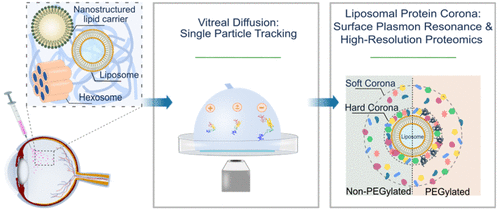当前位置:
X-MOL 学术
›
Mol. Pharmaceutics
›
论文详情
Our official English website, www.x-mol.net, welcomes your feedback! (Note: you will need to create a separate account there.)
Diffusion and Protein Corona Formation of Lipid-Based Nanoparticles in the Vitreous Humor: Profiling and Pharmacokinetic Considerations
Molecular Pharmaceutics ( IF 4.9 ) Pub Date : 2020-06-25 , DOI: 10.1021/acs.molpharmaceut.0c00411 Shirin Tavakoli 1 , Otto Kalevi Kari 1 , Tiina Turunen 1 , Tatu Lajunen 1 , Mechthild Schmitt 1 , Julia Lehtinen 1 , Fumitaka Tasaka 2 , Petteri Parkkila 1 , Joseph Ndika 3 , Tapani Viitala 4 , Harri Alenius 3, 5 , Arto Urtti 1, 6, 7 , Astrid Subrizi 7
Molecular Pharmaceutics ( IF 4.9 ) Pub Date : 2020-06-25 , DOI: 10.1021/acs.molpharmaceut.0c00411 Shirin Tavakoli 1 , Otto Kalevi Kari 1 , Tiina Turunen 1 , Tatu Lajunen 1 , Mechthild Schmitt 1 , Julia Lehtinen 1 , Fumitaka Tasaka 2 , Petteri Parkkila 1 , Joseph Ndika 3 , Tapani Viitala 4 , Harri Alenius 3, 5 , Arto Urtti 1, 6, 7 , Astrid Subrizi 7
Affiliation

|
The vitreous humor is the first barrier encountered by intravitreally injected nanoparticles. Lipid-based nanoparticles in the vitreous are studied by evaluating their diffusion with single-particle tracking technology and by characterizing their protein coronae with surface plasmon resonance and high-resolution proteomics. Single-particle tracking results indicate that the vitreal mobility of the formulations is dependent on their charge. Anionic and neutral formulations are mobile, whereas larger (>200 nm) neutral particles have restricted diffusion, and cationic particles are immobilized in the vitreous. PEGylation increases the mobility of cationic and larger neutral formulations but does not affect anionic and smaller neutral particles. Convection has a significant role in the pharmacokinetics of nanoparticles, whereas diffusion drives the transport of antibodies. Surface plasmon resonance studies determine that the vitreal corona of anionic formulations is sparse. Proteomics data reveals 76 differentially abundant proteins, whose enrichment is specific to either the hard or the soft corona. PEGylation does not affect protein enrichment. This suggests that protein-specific rather than formulation-specific factors are drivers of protein adsorption on nanoparticles in the vitreous. In summary, our findings contribute to understanding the pharmacokinetics of nanoparticles in the vitreous and help advance the development of nanoparticle-based treatments for eye diseases.
中文翻译:

玻璃体液中脂质纳米颗粒的扩散和蛋白冠形成:分析和药代动力学考虑
玻璃体液是玻璃体内注射纳米颗粒遇到的第一个屏障。通过使用单粒子跟踪技术评估其扩散并通过表面等离子体共振和高分辨率蛋白质组学表征其蛋白质冠来研究玻璃体中的基于脂质的纳米粒子。单粒子追踪结果表明制剂的玻璃体迁移率取决于它们的电荷。阴离子和中性制剂是可移动的,而较大的(>200 nm)中性颗粒的扩散受到限制,而阳离子颗粒则固定在玻璃体中。聚乙二醇化增加了阳离子和较大中性制剂的流动性,但不影响阴离子和较小中性颗粒。对流在纳米粒子的药代动力学中起着重要作用,而扩散则驱动抗体的运输。表面等离子共振研究确定阴离子制剂的玻璃体冠是稀疏的。蛋白质组学数据揭示了 76 种差异丰富的蛋白质,其富集特定于硬冠或软冠。聚乙二醇化不影响蛋白质富集。这表明蛋白质特异性因素而不是配方特异性因素是玻璃体内纳米颗粒上蛋白质吸附的驱动因素。总之,我们的研究结果有助于了解纳米颗粒在玻璃体中的药代动力学,并有助于推动基于纳米颗粒的眼部疾病治疗方法的开发。
更新日期:2020-06-25
中文翻译:

玻璃体液中脂质纳米颗粒的扩散和蛋白冠形成:分析和药代动力学考虑
玻璃体液是玻璃体内注射纳米颗粒遇到的第一个屏障。通过使用单粒子跟踪技术评估其扩散并通过表面等离子体共振和高分辨率蛋白质组学表征其蛋白质冠来研究玻璃体中的基于脂质的纳米粒子。单粒子追踪结果表明制剂的玻璃体迁移率取决于它们的电荷。阴离子和中性制剂是可移动的,而较大的(>200 nm)中性颗粒的扩散受到限制,而阳离子颗粒则固定在玻璃体中。聚乙二醇化增加了阳离子和较大中性制剂的流动性,但不影响阴离子和较小中性颗粒。对流在纳米粒子的药代动力学中起着重要作用,而扩散则驱动抗体的运输。表面等离子共振研究确定阴离子制剂的玻璃体冠是稀疏的。蛋白质组学数据揭示了 76 种差异丰富的蛋白质,其富集特定于硬冠或软冠。聚乙二醇化不影响蛋白质富集。这表明蛋白质特异性因素而不是配方特异性因素是玻璃体内纳米颗粒上蛋白质吸附的驱动因素。总之,我们的研究结果有助于了解纳米颗粒在玻璃体中的药代动力学,并有助于推动基于纳米颗粒的眼部疾病治疗方法的开发。



























 京公网安备 11010802027423号
京公网安备 11010802027423号